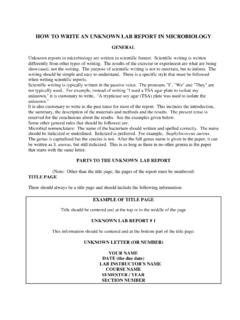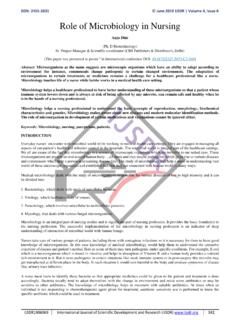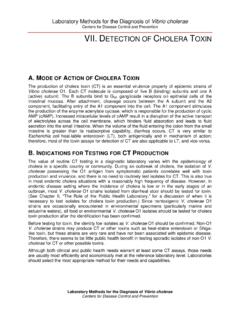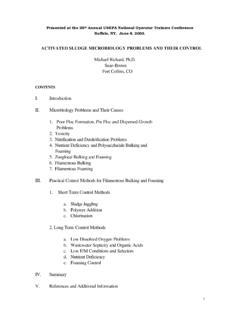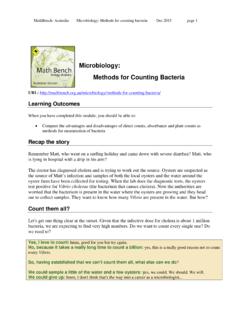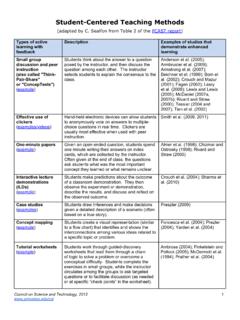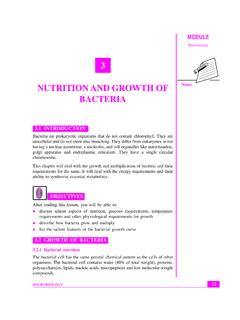Transcription of Chapter 6: Laboratory Identification of Vibrio cholerae
1 Laboratory methods for the Diagnosis of Vibrio cholerae Centers for disease control and prevention 38 | Page Laboratory methods for the Diagnosis of Vibrio cholerae Centers for disease control and prevention VI. Laboratory Identification OF Vibrio cholerae Members of the genus Vibrio are facultatively anaerobic, asporogenous, motile, curved or straight gram-negative rods. Vibrios either require NaCl or have their growth stimulated by its addition. All members of the genus Vibrio , with the exceptions of V. metschnikovii and V. gazogenes, are oxidase positive and reduce nitrates to nitrites. Within the Vibrionaceae are many different species, most of which are normal inhabitants of the aquatic environment.
2 Of the more than 30 species within the Vibrio -Photobacterium complex, only 12 have been recognized as being pathogens for humans (Table V1-I). Although most of these 12 species are isolated from intestinal as well as extraintestinal infections, only V. cholerae is associated with epidemic cholera. Unidentified vibrios have been called marine species, or simply, marine vibrios. These marine species are defined as Vibrio or Photobacterium strains that are oxidase positive, ferment D-glucose, do not grow in nutrient broth without added NaCl, but do grow in nutrient broth with add NaCl. Most organisms isolated from ocean or estuarian waters belong to the marine Vibrio group and are difficult to identify except in a few specialized laboratories.
3 Because they are not associated with human illness, marine vibrios need not be identified on a routine basis. Clinical and public health laboratories usually report the human pathogenic vibrios by genus and species and all other vibrios as marine Vibrio . The minimum Identification of V. cholerae O1 requires only serologic confirmation of the presence of O1 serotype antigens with suspect isolates. However, a more complete characterization of the organism may be necessary and may include various biochemical tests as well as the determination of other characteristics. The Laboratory should decide when it is appropriate to perform these additional tests on clinical isolates, since they should not be a routine part of Identification of V.
4 cholerae O1. Generally, if the isolate is from a region that is threatened by epidemic cholera or is in the early stages of a cholera outbreak, it is appropriate to confirm the production of cholera toxin and biochemical Identification . Other tests that could provide important public health information include hemolysis, biotyping, molecular subtyping, and antimicrobial sensitivity assays. These tests should be performed on only a limited number of isolates. (See Chapter II, The Role of the Public Health Laboratory . ) A. Serologic Identification of V. cholerae O1 The use of antisera is one of the most rapid and specific methods of identifying V. cholerae O1.
5 Although identifying the serogroup and serotype of V. cholerae isolates is not necessary for treatment of cholera, this information may be of epidemiologic and public health importance (Table VI-2.) Laboratory Identification of Vibrio cholerae 39 | Page Laboratory methods for the Diagnosis of Vibrio cholerae Centers for disease control and prevention Laboratory Identification of Vibrio cholerae 40 | Page Laboratory methods for the Diagnosis of Vibrio cholerae Centers for disease control and prevention Laboratory Identification of Vibrio cholerae 41 | Page Laboratory methods for the Diagnosis of Vibrio cholerae Centers for disease control and prevention Table VI-2.
6 Characteristics of Vibrio cholerae a Nontoxigenic O1 strains exist, but are not epidemic-associated 1. Serogroups of V. cholerae Currently, there are more than 130 serogroups of V. cholerae , based on the presence of somatic O antigens. However, only the O1 serogroup is associated with epidemic and pandemic cholera. Other serogroups may be associated with severe diarrhea, but do not possess the epidemic potential of the O1 isolates and do not agglutinated in O1 antisera. Isolation of V. cholerae non-O1 from environmental sources in the absence of diarrheal cases is common. Laboratories may choose not to report the isolation of V.
7 cholerae non-O1 when investigating cholera epidemics, since health care providers or public health officials may be unaware of the important epidemiologic differences between O1 and non-O1 isolates. The name Vibrio cholerae on a Laboratory report may incorrectly imply that a non-O1 isolate is of epidemiologic importance. Confusion may be eliminated by reporting only whether V. cholerae serogroup O1 was or was not isolated. 2. Serotypes of V. cholerae O1 Isolates of the O1 serogroup of V. cholerae have been further divided into three serotypes, Inaba, Ogawa, and Hikojima (very rare). Serotype Identification is based on agglutination in antisera to type-specific O antigens (see Table VI-3).
8 Identifying these antigens is valid only with serogroup 1 isolates. For this reason, Inaba and Ogawa antisera should never be used with strains that are negative with polyvalent O1 antisera. Isolates that agglutinate weakly or slowly Classification Method Epidemic-associated Not epidemic-associated Serogroups O1 Non-O1 (>130 exist) Biotypes Classical, El Tor Biotypes not applicable to non-O1 strains Serotypes Inaba, Ogawa, Hikojima These 3 serotypes not applicable to non-O1 strains Toxin Produce cholera toxina Usually do not produce cholera toxin; sometimes produces other toxins Laboratory Identification of Vibrio cholerae 42 | Page Laboratory methods for the Diagnosis of Vibrio cholerae Centers for disease control and prevention with serogroup O1 antisera but do not agglutinate with either Inaba or Ogawa antisera are not considered to be serogroup O1.
9 Table VI-3. Identifying characteristics of serotypes of V. cholerae serogroup O1 Agglutination in absorbed serum Serotype Major O factors Present Ogawa Inaba Ogawa A, B + - Inaba A, C - + Hikojima A, B, C + + Strains of one serotype frequently cross-react slowly and weakly in antiserum to the other serotype, depending on how well the serotype-specific antisera have been absorbed. Agglutination reactions with both Inaba and Ogawa antisera should be examined simultaneously, and the strongest and most rapid reaction should be used to identify the serotype. With adequately absorbed antisera, strains that agglutinate very strongly and equally with both the Ogawa and Inaba antisera are rarely, if ever, encountered.
10 If such reactions are suspected, the strains should be referred to a reference Laboratory for further examination and may be referred to as possible serotype Hikojima. 3. Slide agglutination Agglutination tests for V. cholerae somatic O antigens may be carried out in a petri dish or on a clean glass slide. An inoculating needle or loop, or sterile applicator stick, or tooth pick is used to remove a portion of the growth from the surface of heart infusion agar (HIA), Kligler s iron agar (KIA), triple sugar iron agar (TSI), or other nonselective agar medium. Emulsify the growth in a small drop of physiological saline and mix thoroughly by tilting back and forth for about 30 seconds.










